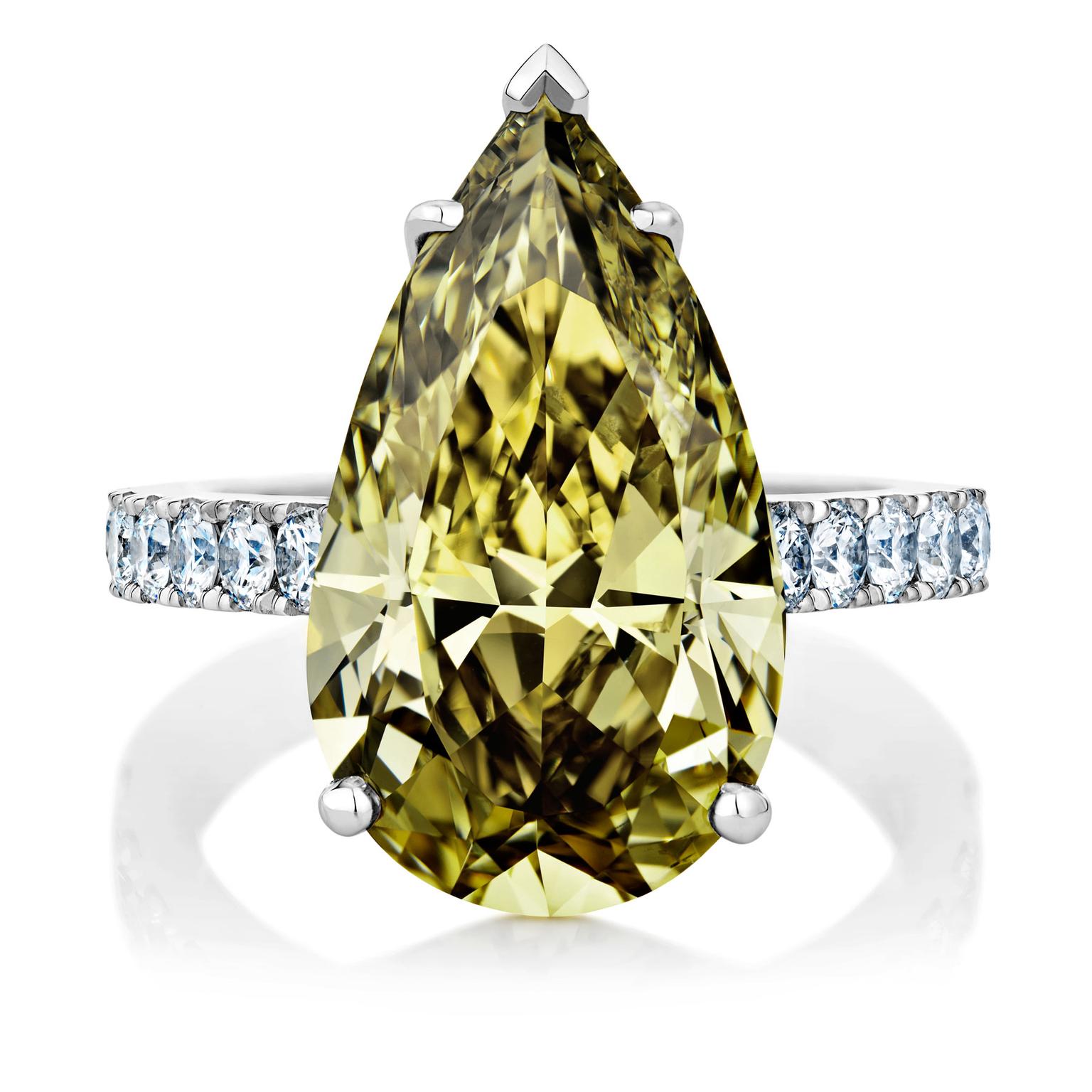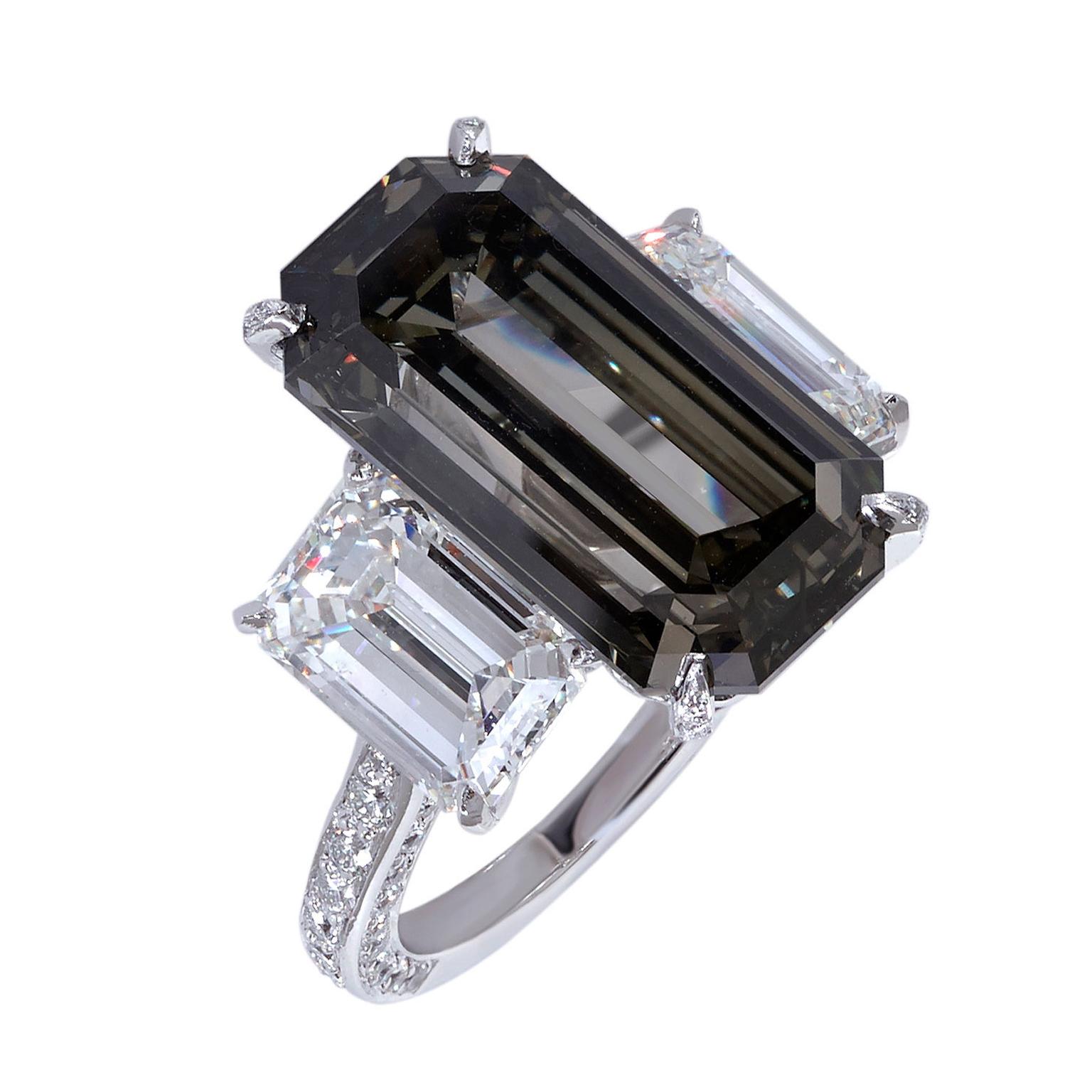Some of the most memorable gems The Jewellery Editor team has seen recently were De Beers’ Master Diamonds in unusual hues, from Fancy Dark Brown Yellow to Fancy Greenish Yellow. But most arresting was a 4.27-carat Fancy Grey marquise-cut diamond with a hint of blue set into a ring, below.
Bathed in the winter sun, the soft light it gave off was mesmerising and quite unlike anything we had seen before, and its strange beauty got us thinking about colour diamonds beyond the more usual pink, blue and yellow, and those that contain a combination of more than one colour.
In the swirling gases and forces at work deep in the body of our young planet, millions of years ago, nature created diamonds in all manner of colour combinations. Clear whites, pure yellows, pinks and blues have traditionally been the most sought-after, but colour diamonds with a secondary moderator hue, such as a green, grey, yellow, purple or blue, are stepping out of the dark.
Adventures in colour
A visit to Bond Street’s top diamantaires reveals that there is indeed a quiet chromatic revolution going on. Only a decade ago, straight-up top-grade pink, blue and yellow diamonds were the only acceptable colour solitaire to flash to show both sophistication and deep pockets. But it seems we are warming to more adventurous choices in our search for something truly different.
Coloured or fancy diamonds – as the Americans refer to any diamond that exhibits colour beyond the Z range, or diamonds that exhibit any other colour face-up – are graded by their dominant colour, such as pink, yellow, blue or green, and then by the secondary or moderating colour.

The authoritative Gemological Institute of America (GIA) created the useful circular chart above to shows how the different colours flip through the spectrum, from, say, Orangy Red to Reddish Orange. In the introduction, editor John M King explains: “For most people, colour is an intuitive response rather than a true knowledge of the systematic ordering of colour appearances. Both, however, are crucial when the romance of colour also becomes the business of colour.”
But not all colour diamonds are equal, and some colour combinations work better than others. It is generally accepted that purplish pink is a pretty combination, as is blue green or green blue. What the diamonds we have selected all have in common is that they are all an appealing balance of hue, tone and saturation.
Grading colour diamonds
The complexity of grading and pricing these stones has been both their ally and their downfall as valuing them is something of a minefield. While whites have well-respected online price charts that are constantly updated, there is no reference for orange and green diamonds, never mind the variations of moderating colours.

But what is clear is that the pure colours, such as green or orange, command higher prices, and the majority of auction record breakers are single colour top-of-the-range Fancy Vivids, such as the 15.38 carat Unique Pink that sold for $31.5 million or the 14.62 carat Oppenheimer Blue, purchased for $57.5 million. Much like the art market, prices can be arbitrary, with deals taking place behind closed doors and no auction reference prices to rely on. But we know from the experts on Bond Street that a 3-carat Vivid Orange diamond would sell for say $7 million, while a Vivid Yellowish Orange would possibly only fetch $2 million.
Pricing issues aside, the grande dame of diamonds on Bond Street, the formidable Mrs Moussaieff – or Mrs M to those who know her – declares: “Unusual coloured diamonds are certainly becoming more sought after as people become far more educated about diamonds. Clients from the Far East and the Middle East are buying anything from Grey to Yellowish Green or Greenish Yellow. They also love Orangey Yellow and Orangey Pink. The most unusual diamond I have ever seen was a beautiful Violet colour.”
Moussaieff’s 11.07-carat Fancy Dark Grey VVS1 emerald-cut diamond, above, has a smoky allure that, in my opinion, leaves other colour diamonds in the shade. And this is a case of me falling for what John M King of the GIA so aptly described as “an intuitive response rather than a true knowledge”.
Green diamonds
Even more of an anomaly are green diamonds. Created when radiation jiggled around the carbon atoms from their normal positions, they are so rare that I can count on one hand the number I have seen. Artificially radiated greens have made us shy of these diamonds, but a natural green diamond, untouched by man, is a beautiful sight.
One the most fabulous we have spotted is Moussaieff’s 6.51-carat Yellowish Green diamond, above, while Chatila of Bond Street recently showed us this zesty Fancy Intense Yellow Green diamond, below, accompanied by pink diamond pavé.
Only 15 years ago, jewellers were unsure what to make of these unusual colours, never mind straight greens. “Dad saw an amazing green diamond 15 years ago, but didn’t really understand it,” laments Jody Wainwright, gemologist at family-owned jeweller Boodles, at having missed a bargain. “Unusual colours are really exciting as they are less commoditised because they are truly rare. So prices are still a bit arbitrary and more subjective.”
When unusual colour diamonds meet great design, the magic really starts to happen. London-based Jessica McCormack has a talent for making big diamonds look informal and easy to wear. “Grey diamonds provide a warmer, softer aesthetic whilst maintaining the similar fire and light reflection of a white diamond,” says Jessica. “I designed the Daisy ring around the stone as natural grey diamonds of this quality and clarity are quite rare. When you find one, they are so enticing – they really add another dimension to the piece.”
Colour-diamond expert Louise Kruger offers advice: “Coloured diamonds is a specialised category, and you need specialist advice to know your way through the overtones. You can make the best investments possible with colour diamonds, but also the worst ones. ‘Beauty is in the eye of the beholder’, as they say, so if you fall in a love with a specific colour, make sure you are paying its real value and not your perception.”

























